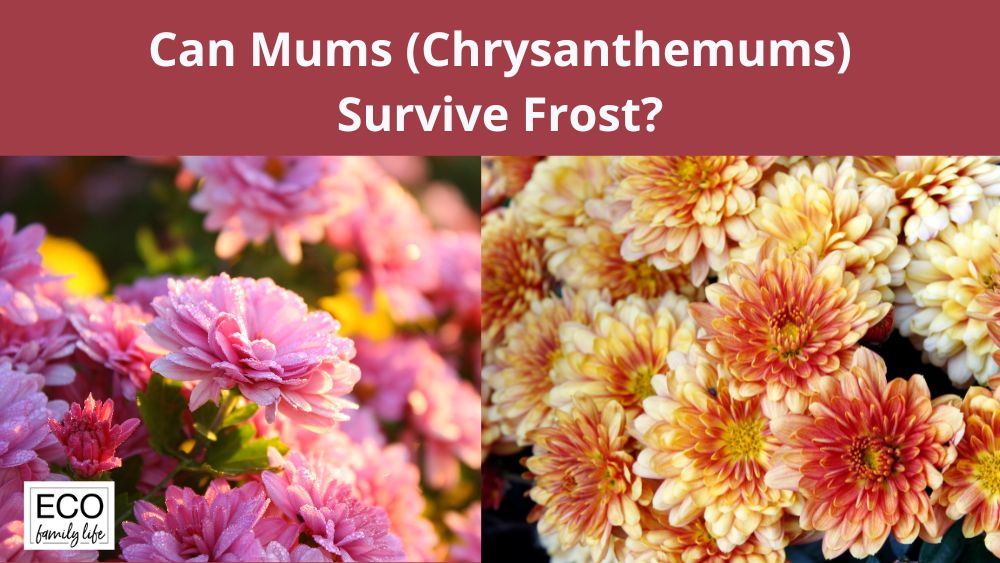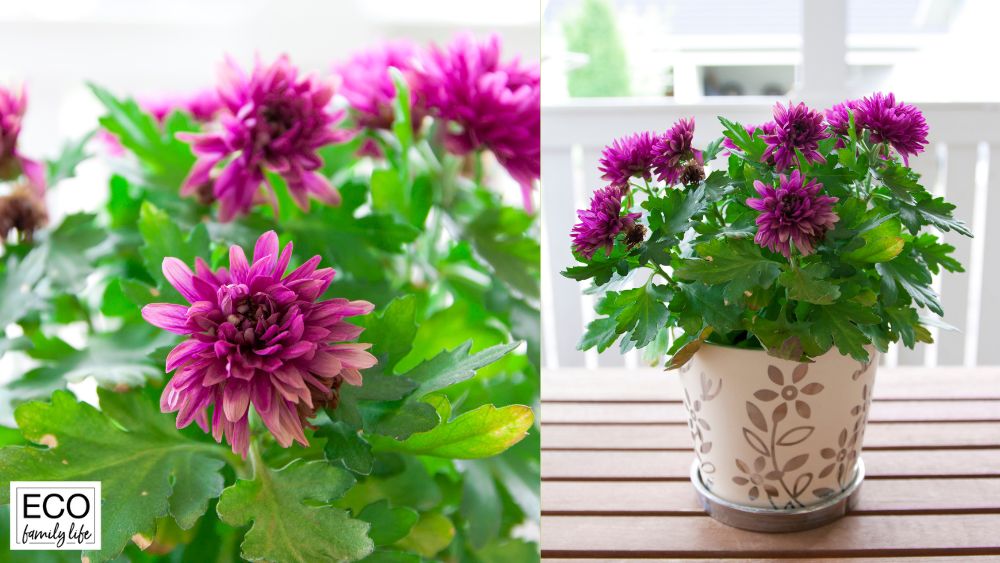Chrysanthemums add color to your fall garden, but are they able to survive cold weather? While mums can handle some cool temperatures, the truth is that a hard frost will kill the roots of the plant. Because of this, you’re better off taking measures to keep them away from frost and extremely cold temperatures as much as possible.

7 Ways to Protect Mums from Frost
In the fall, two types of mums are for sale: garden mums, also called hardy mums, and floral mums. The main difference is the hardy mums will come back year after year, while floral mums will not. To protect your mums from frost, keep the following tips in mind:
1. Always Keep Your Mums in Containers
You might be tempted to plant your mums in the garden, but this is not the best idea. The truth is that even in warmer climates, there’s always the chance a frost could come along and kill your mums.
Always keep them in pots or containers so that you can bring them inside when you know the temperature is going to get low. If you do plant them outside, you’ll have to keep a close eye on them.

2. Choose the Right Soil
Always have soil that drains well in your mum’s container. Choose a pot that allows excess water to drain out to the bottom.
In most cases, the cold doesn’t kill the mums, but it’s the ice and frost that form around the roots that does it. This is why it’s important for all excess water to drain out of your container.
3. Never Put Your Mums in a Windy Area
Whether you plant your mums in the ground or in containers, keep them away from any area that gets windy.
If the area is windy during the fall and winter months, it will increase the odds of frost appearing on the roots and on the blossoms of the mums, which can eventually kill them.
4. Insulate the Plants During the Fall
Every fall, you’ll need to insulate your mums. The best way to do this is to provide a heavy layer of mulch, made out of either straw or leaves, over the plant.
Do this after the ground has frozen to keep the temperature the same week after week. If the ground freezes then unfreezes continuously, it can damage the plant more than it would if the ground remains frozen.
5. Cut the Plant Back
In the fall, the leaves of the plant will turn brown and die. When this happens, cut back the stems and leave only three to four inches above the soil (or above the ground, depending on where the mums are planted).
Don’t cut the stems back too far because if they’re too short, they won’t grow as successfully the following year.
Check out this great video that shows how to prune your mums in fall for a second bloom.
6. Water Your Mums Regularly
While mums are blooming, make sure you water the mums regularly. When you first buy your mums, they’ll be a little top-heavy and may start to dry out, which is something you’ll want to avoid.
Before you plant them in a bigger container or in the ground, they have to be well-watered so the roots get the moisture they need to grow stronger.
7. Never Let Them Freeze When They’re in a Container
Keep in mind that if your mums are in a pot or container, your goal should be to never let them freeze—not even once.
While light frosts and fairly cold weather usually don’t hurt them, one hard freeze can kill the roots even in hardy mums, which means you won’t be able to enjoy them again the following year. If you know it’s going to freeze during the night, bring your mums inside to safety.
For more on caring for mums, check out this video.
When Is It Too Cold for Mums?
Chrysanthemums grow best if you live in growing zones 4–9, and they can tolerate a little bit of cold weather and frost. That being said, it’s best to bring them inside once the temperature reaches below 20 degrees Fahrenheit.
You can bring them in if there is a chance of a freeze (a temperature of 32 degrees) if you like, but they’ll definitely need to be brought inside once the temperature reaches 20 degrees.
Will Mums Grow Back After Frost Damage?
If you have planted floral mums, they will not come back after a freeze. If you plant hardy mums, they will likely come back after a freeze, provided they haven’t experienced a freeze more than once and it hasn’t stayed too cold for too long. To help them survive the winter, follow these tips:
Always Deadhead
Mums will lose their leaves and blossoms over the winter months, so make sure you remove any flowers that manage to stay on the plant when the weather gets cold. To a newbie, this action sometimes feels counterintuitive, but it is a good way to protect your mums in the wintertime.
Check out this video that talks through the steps for mum care in fall.
Remember Your Growing Zone
Mums can be grown successfully in zones 4–9, but if you live in zones 4–7, always add more mulch to outdoor mums or bring potted mums indoors whenever it’s going to get too cold outside.
If you live in zones 8–9, you might not have to do this because the temperature will likely not drop low enough to cause concern.
Give Them Attention During the Cold Months
Throughout the winter, you’ll still need to feed, water, and prune your mums so they can stay alive and healthy.
They won’t need daily watering, so water them only when the soil starts to look dry, and aim for watering the top 2 inches of soil and no more. They won’t need any more water than that.
Conclusion
Taking care of mums is not difficult, and in fact, they are a great plant for beginners. As long as you keep in mind that they should never be exposed to frost or temperatures that fall below 20 degrees Fahrenheit and as long as you do what you’re supposed to do during the winter months, your hardy mums should come back year after year.
I am an accredited practicing dietitian, experienced gardener and a dedicated cook. I love writing and sharing my experience so you can learn from my successes and mistakes.
